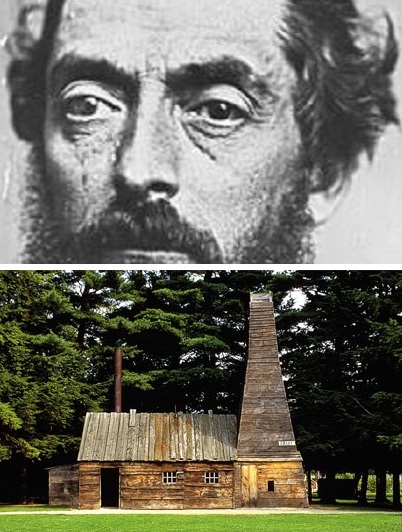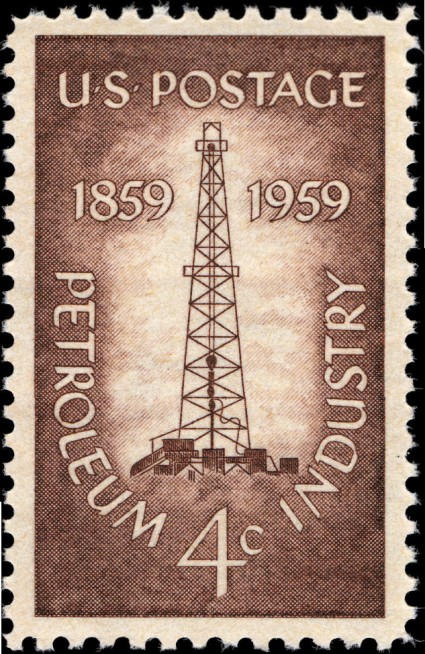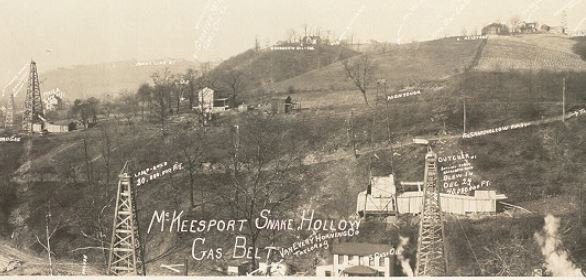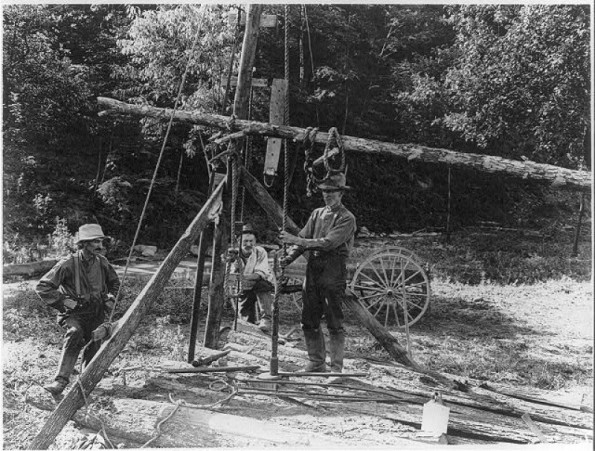August 26, 1926 – The Texas Company expands –
After years of growth thanks to discoveries at Spindletop and Sour Lake, the Texas Corporation incorporated in Delaware, acquiring the outstanding stock of the Texas Company (Texas), which was dissolved by the next year.

Texaco was founded in Beaumont as the Texas Company one year after the 1901 discovery of a giant oilfield at Spindletop Hill.
The new corporation moved its headquarters from Houston to New York City and became parent company of all Texas Company entities and other subsidiaries, including the Texaco brand — a name derived from its original New York City telegraph office address, and officially adopted in 1959.
Learn more in Histories of Indian Refining, Havoline, and Texaco.
August 26, 2009 – Oil Refinery designated Historic Landmark
The American Chemical Society (ACS) designated the development of the first U.S. still for refining oil as a National Historic Chemical Landmark in a ceremony in Pittsburgh, Pennsylvania. The society also dedicated a plaque 100 miles north, at the Drake Well Museum in Titusville, as part of celebrations for the 150th anniversary of the U.S. petroleum industry.
ACS noted that in the 1850s, Samuel Kier constructed a one-barrel, cast-iron still and began selling distilled petroleum, which he called “carbon oil,” for a $1.50 a gallon. “Kier’s refining process touched off the search for more dependable sources of crude oil, which led to the drilling of the nation’s first oil well,” noted ACS on the Pittsburgh plaque. “These two technologies — refining and drilling — made western Pennsylvania the undisputed center of the early oil industry.”
August 27, 1859 – Birth of U.S. Petroleum Industry
America’s petroleum industry began with a well drilled 69.5 feet deep in Titusville, Pennsylvania. Hired by the Seneca Oil Company of New Haven, Connecticut, former railroad conductor Edwin L. Drake drilled the first commercial U.S. oil well. The Venango County well produced 25 barrels of oil a day.

The Drake Well Museum and Park includes a replica of the oil well that forever changed the world.
Although earlier “spring pole” and cable-tool drillers of brine wells had found small amounts of oil – an unwanted byproduct – Drake specifically drilled for it. His investors wanted to refine the oil into kerosene for lamps and other petroleum products, Drake also pioneered new technologies, including driving an iron pipe downhole to protect the bore’s integrity from nearby Oil Creek.
After five months of financial setbacks and cable-tool drilling problems, many locals called the well “Drake’s Folly.” To improve his reputation, Connecticut investors addressed letters to “Colonel” Edwin Drake.

Ceiling paintings capture the industry’s earliest scenes inside the Titusville Trust Building, which opened in 1919. A seated Edwin Drake is flanked by men holding cable tools – symbols of early oilfield technology. Photos by Bruce Wells.
Late in the afternoon on August 27, 1859, Drake’s driller, blacksmith “Uncle Billy” Smith, noticed oil floating at the top of the pipe. The bit had reached what would become known as the First Venango Sand. To begin pumping the oil, Drake borrowed a kitchen water pump.
August 27, 1959 – Stamp celebrates Oil Centennial
“No official act could give me greater pleasure than to dedicate this stamp commemorating the 100th anniversary of the petroleum industry,” declared U.S. Postmaster General Arthur Summerfield, who addressed a crowd gathered for the “Oil Centennial Day” in Titusville, Pennsylvania.
“The American people have great reason to be indebted to this industry,” the Postmaster General added. “It has supplied most of the power that has made the American standard of living possible.”

The U.S. Postal Service issued 120 million centennial oil stamps. Efforts for a 2009 anniversary stamp were unsuccessful.
The U.S. Postal Service Stamp Advisory Committee in 2009 rejected requests for a stamp recognizing the 150th anniversary of the U.S. petroleum industry. The committee earlier granted 10 commemorative stamps for Kermit the Frog and nine other Muppets.
Learn more in the Centennial Oil Stamp Issue.
August 30, 1919 – Natural Gas Boom (and Bust) in Pennsylvania
The “Snake Hollow Gusher” of McKeesport, Pennsylvania, revealed a natural gas field that soon attracted hundreds of exploration companies. Drilled near the Monongahela River southeast of Pittsburgh, the discovery well produced 60 million cubic feet of gas a day. The drilling frenzy it inspired resulted in $35 million invested in a nine-square-mile area.

“McKeesport, Snake Hollow, Gas Belt” from a circa 1920 panoramic image by Hagerty & Griffey. Photo courtesy Library of Congress.
“Many residents signed leases for drilling on their land,” the local newspaper reported. “They bought and sold gas company stock on street corners and in barbershops transformed into brokerage houses.”
The excitement ended in early 1921 when gas production declined in 180 wells and more than 440 exploratory wells found no gas. The field was later described as “the scene of the Pittsburgh district’s biggest boom and loudest crash.”
Learn more in McKeesport Gas Company.
August 30, 2002 – Conoco and Phillips Petroleum become ConocoPhillips
Almost 100 years after Frank and L.E. Phillips completed their first oil well and 128 years after Continental Oil delivered its first can of kerosene in a horse-drawn wagon, Phillips Petroleum and Conoco combined to form ConocoPhillips.

An 1880s Continental Oil Company horse-drawn tank wagon welcomes visitors to the Conoco Museum in Ponca City, Oklahoma. The Phillips Petroleum Company Museum is 70 miles east in Bartlesville. Photo by Bruce Wells.
Earlier petroleum companies that played key roles leading to ConocoPhillips included Transcontinental Oil & Transportation, 101 Ranch Oil, Marland Oil, and Continental Oil and Refining.
As part of the 2007 celebration of Oklahoma’s centennial, ConocoPhillips opened two oil museums, one in Ponca City and another Bartlesville. Phillips 66 again became independent in 2012, when the company separated its refining and marketing businesses in 2012.
August 31, 1850 – San Francisco Utility manufactures Gas from Coal
The San Francisco Gas Company incorporated in 1850 to produce and distribute manufactured gas extracted from coal. Irish immigrants Peter and James Donahue and engineer Joseph Eastland erected a “gasification plant” to distill coal for manufacturing the gas for lighting. Their company illuminated San Francisco’s first “town gas” street lamps in 1852.
Over the next 50 years, the gas company merged with competitors, ultimately becoming Pacific Gas & Electric (PG&E) in 1905. By 1915, there were almost 8,500 San Francisco street lamps — each hand lit and shut off every day. The last coal-gas lamp was extinguished in 1930.
Learn about one of the earliest and largest gas utilities, Consolidated Edison, in History of Con Ed.
August 31, 1859 – U.S. Petroleum Industry’s First “Dry Hole”
Just four days after the first American oil well in Titusville, Pennsylvania, a series of far less known “firsts” were achieved by local entrepreneur John Grandin in August 1859.

A spring-pole similar to the one above was used in 1859 to drill America’s first dry hole, which was deeper than the nearby Drake well. Photo from “The World Struggle for Oil,” a 1924 film by the Department of the Interior.
Grandin drilled using the simple (and ancient) spring-pole “kick down” method at Gordon Run Creek. His well found no oil, but achieved several petroleum industry milestones. His attempt would be credited with the first stuck tool, the first “shooting” of a well with black powder, and first well ruined by a failed shooting attempt.
Learn more in First Dry Hole.
August 31, 1871 – Birth of “The Father of Route 66”
Cyrus Stevens Avery, an Oklahoma independent producer who became known as “The Father of Route 66,” died in Los Angeles at age 91. After moving to Oklahoma in 1897, Avery sold life insurance in Oklahoma City before starting the Avery Oil and Gas Company in 1908, during the Tulsa oil boom.
By 1916, after describing Tulsa as “little town without lights” with “pigs running loose in the streets,” the independent producer “helped lay out a state road plan and the national highway numbering system, becoming the champion of a road from Chicago to Los Angeles we know as Route 66,” according to the Tulsa Historical Society (THS).
September 1, 1862 – Union taxes Manufactured Gas
To help fund the Civil War, a new federal tax was placed on manufactured gas, a popular fuel for street and residential lighting. Manufactured gas (produced from coal) was taxed up to 15 cents per thousand cubic feet. The Brooklyn Daily Eagle quickly accused the local gas company of passing on the tax, which “shifts from its shoulders its share of the burdens the war imposes and places it directly on their customers.”
_______________________
Recommended Reading: The Texaco Story: The First Fifty Years, 1902-1952 (2012); The Extraction State, A History of Natural Gas in America (2021); Myth, Legend, Reality: Edwin Laurentine Drake and the Early Oil Industry
(2009); Black Gold: The Philatelic History of Petroleum
(1995); McKeesport – Images of America: Pennsylvania
(2007); Conoco: 125 Years of Energy
(2000); Phillips, The First 66 Years
(1983); Western Pennsylvania’s Oil Heritage
(2008); Growing Up In The Bradford Oil Fields
(2008); History Of Oil Well Drilling
(2007); The American Highway: The History and Culture of Roads in the United States
(2000). Your Amazon purchase benefits the American Oil & Gas Historical Society. As an Amazon Associate, AOGHS earns a commission from qualifying purchases.
_______________________
The American Oil & Gas Historical Society (AOGHS) preserves U.S. petroleum history. Please become an AOGHS annual supporter and help maintain this energy education website and expand historical research. For more information, contact bawells@aoghs.org. Copyright © 2024 Bruce A. Wells. All rights reserved.



